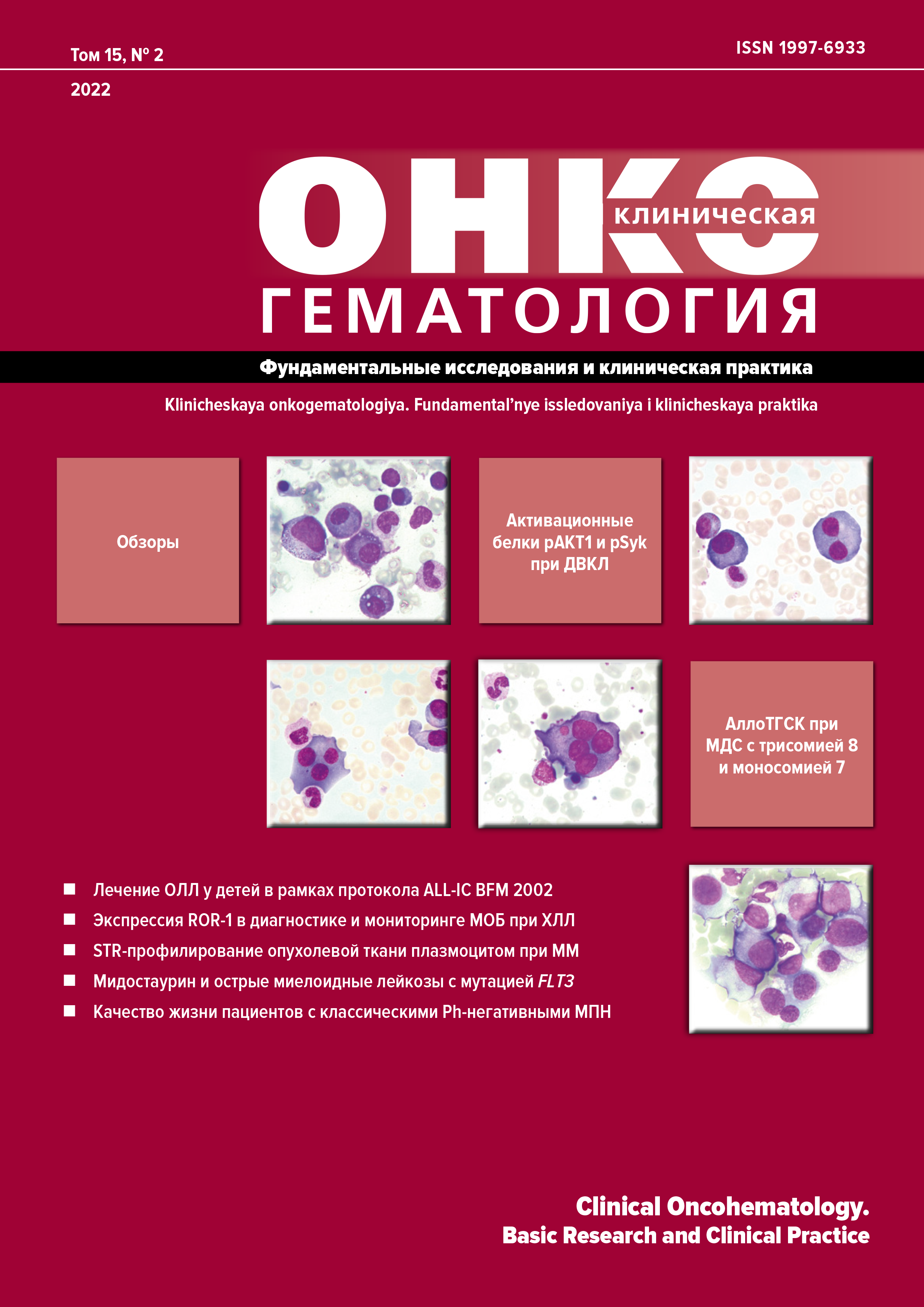Abstract
Background. Programs of pediatric acute lymphoblastic leukemia (ALL) treatment, developed by the BFM (Berlin-Frankfurt-Munster) Group in 2002, remain one the most effective in the world. Long-term (10–15 years) overall survival in ALL children is above 90 %. Great progress in ALL treatment provided ground for including the ALL-IC BFM 2002 protocol into the Clinical Guidelines in 2020 (ID: 529).
Aim. To present the outcomes of ALL treatment in children according to ALL-IC BFM 2002 under the multi-center clinical trial.
Materials & Methods. From 01.11.2003 to 12.10.2021 the multi-center retrospective-prospective trial included 433 patients with newly diagnosed ALL, aged between 3 months and 21 years. The patients were aged from 0 to 12 (n = 344), from 12 to 18 (n = 70), and older than 12 years (n = 19). All of them were treated with ALL-IC BFM 2002. Overall (OS), disease-free (DFS), and event-free (EFS) survivals were estimated as of 01.12.2021.
Results. In the vast majority of patients (97.9 %, n = 424) complete clinical hematological remission was reached by Day 33 of the ALL-IC BFM 2002 treatment. The 10-year OS was 91.8 ± 1.5 %, DFS was 87.4 ± 1.8 %, and EFS was 84.1 ± 1.9 %. The 10-year OS in the groups of standard- and intermediate-risk patients was 92.8 ± 1.7 % and 94.6 ± 2.6 %, respectively, whereas in high-risk ALL relapse patients it was 71.1 ± 11.1 %.
Conclusion. The ALL-IC BFM 2002 protocol for treating pediatric ALL is reproducible in federal and regional clinics. The outcomes of the ALL-IC BFM 2002 treatment appeared to be impressive. They are comparable to those achieved in leading European and American clinics. To improve survival of high-risk patients, additional stratifying criteria are required, one of which should be the assessment of minimal residual disease (MRD). MRD detection became a basis for prognostic risk stratification under ALL-IC BFM 2009, the results of which will be presented in 2022–2023.
References
- Румянцев А.Г. Эволюция лечения острого лимфобластного лейкоза у детей: эмпирические, биологические и организационные аспекты. Вопросы гематологии/онкологии и иммунопатологии в педиатрии. 2015;14(1):5–15.
- [Rumyantsev AG. Evolution of treatment of acute lymphoblastic leukemia in children: empirical, biological and organizational aspects. Voprosy gematologii/onkologii i immunopatologii v pediatrii. 2015;14(1):5–15. (In Russ)]
- Pinkel D. History and development of total therapy for acute lymphocytic leukemia. In: Murphy SB, Gilbert JR, eds. Leukemia research: advances in cell biology and treatment. New York: Elsevier Science Publ.; 1983. pp. 189–201.
- Riehm H, Gadner H, Henze G, et al. Acute lymphoblastic leukemia: treatment in three BFM studies (1970–1981). In: Murphy SB, Gilbert JR, eds. Leukemia research: advances in cell biology and treatment. New York: Elsevier Science Publ.; 1983. pp. 251–63.
- Langermann HJ, Henze G, Wulf M, Riehm H. Estimation of tumor cell mass in childhood acute lymphoblastic leukemia: prognostic significance and practical application. Klin 1982;194(4):209–13. doi: 10.1055/s-2008-1033807.
- Riehm H, Feickert HJ, Schrappe М, et al. Therapy results in five ALL-BFM studies since 1970: implications of risk factors for prognosis. Haematol Blood Transfus. 1987;30:139–46. doi: 10.1007/978-3-642-71213-5_21.
- Moricke A, Zimmermann M, Reiter A, et al. Long-term results of five consecutive trials in childhood acute lymphoblastic leukemia performed by the ALL-BFM study group from 1981 to 2000. Leukemia. 2010;24(2):265–84. doi: 10.1038/leu.2009.257.
- Sullivan МP, Chen Т, Dyment PG, et al. Equivalence of intrathecal chemotherapy and radiotherapy as central nervous system prophylaxis in children with acute lymphatic leukemia: a Pediatric Oncology Group study. Blood. 1982;60(4):948–58.
- Bleyer WA, Coccia PF, Sather HN, et al. Reduction of central nervous system leukemia with a pharmacokinetically derived intrathecal methotrexate dosage regimen. J Clin Oncol. 1983;1(5):317–25. doi: 10.1200/JCO.1983.1.5.317.
- Sackmann-Muriel F, Felice MS, Zubizarreta PA, et al. Treatment results in childhood acute lymphoblastic leukemia with a modified ALL-BFM’90 protocol: lack of improvement in high-risk group. Leuk Res. 1999;23(4):331–40. doi: 10.1016/s0145-2126(98)00162-3.
- Moricke A, Reiter A, Zimmermann M, et al. Risk-adjusted therapy of acute lymphoblastic leukemia can decrease treatment burden and improve survival: treatment results of 2169 unselected pediatric and adolescent patients enrolled in the trial ALL-BFM 95. 2008;111(9):4477–89. doi: 10.1182/blood-2007-09-112920.
- Stary J, Zimmermann M, Campbell M, et al. Intensive chemotherapy for childhood acute lymphoblastic leukemia: results of the randomized intercontinental trial ALL IC-BFM 2002. J Clin Oncol. 2014;32(3):174–84. doi: 10.1200/JCO.2013.48.6522.

This work is licensed under a Creative Commons Attribution-NonCommercial-ShareAlike 4.0 International License.
Copyright (c) 2022 Clinical Oncohematology
